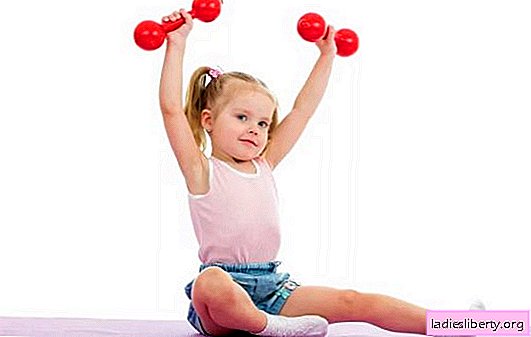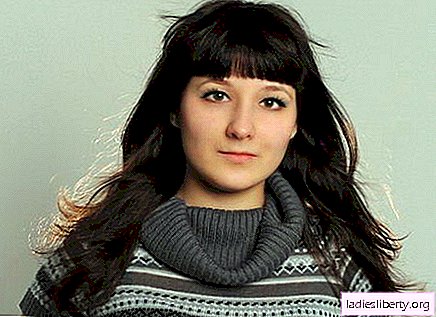
Exercises for stretching and maintaining muscle tone are important not only for adults, but also for children.
Doctors assure that regular strength training, adapted to the child’s capabilities, increase his self-esteem, have a good effect on discipline and the development of intellectual abilities.
Pupils involved in sports adapt more easily in society. And this is just a list of indirect effects on socialization and mental health. Properly planned loads also improve the physical condition of the child.
Muscle exercises for children: who needs them
Stretching the muscles and improving their tone increase the overall endurance of the child. It becomes easier for him to maintain general activity, go for walks and hiking, and engage in school. This type of load is suitable for all children who have no medical restrictions for him.

Of course, this kind of training should not become the intense training prescribed by professional athletes. Classes should be planned taking into account the recommendations of physical education teachers or experienced trainers.
Children need muscle exercises in several cases:
• in the presence of general muscle weakness;
• with unstable muscle tone and tendons;
• with a problem with coordination against a background of increased activity;
• just to increase the overall tone of the body and improve stamina.
Caution: make sure your child is physically able to withstand the training program. If it is observed by a doctor, consult a doctor before starting to adhere to the training regimen.
In fact, such a complex will not hurt each child. It is not necessary to make an athlete out of a kid, but it makes sense to increase his endurance when doing school assignments and homework.
Muscle exercises for children: what is important to do before training
Fitness for children is different from the training system for adults. It’s important to consider several points before you and your child go to the gym.
1. Motivate the child. Children hardly endure the routine, but love to play. Use this. For example, there are complexes of exercises for the development of coordination, which can be imagined as if they were tricks of a magician in a circus. Every child dreams of turning into a circus fakir or clown for a while. Try to play this with him in training.
2. Use the competition. In a group of children, this is easier. It is only important to ensure that each of them is a winner. If you work with a group of children or train several of your own, observe who can do what is best. And conduct competitions so that each of them wins from time to time. It motivates well, sets goals for improving skills, increases the child’s self-esteem, helps him to look at his achievements from the side. In individual lessons, you can maintain a table of achievements and surpass yourself, achieving all the best and best results.
3. Quality over quantity. Muscle exercises should be given to children so that they can perform them. Let the baby push it out once, but well, than three times, but with support. It makes no sense to repeat the exercises many times if they turn out badly. The increase in load should be gradual and take into account the capabilities of the child.
Muscle exercises for children: a list of exciting options
Motivation for playing sports in children is the most important component of success. It is not worth agreeing with the child’s reluctance to do muscle exercises, but there is also no need to push. Having worked out the motivation system, it is important to select a list of specific options that will suit the child by age, according to the state of his muscular system. You will have to show creativity so that the child does not lose interest in the lessons before at least some results are achieved.

You can list several interesting options for exercises, it is appropriate to carry out both at home and on the street.
Artful monkey. This type of exercise is suitable for walking on the playground, for home, if you have a special wall. A horizontally placed grid is required, the distance from which to the ground or floor is greater than the height of the child. The child must pass through the entire lattice in his arms, swaying to intercept from one beam to another. This type of exercise develops coordination, improves muscle strength in the upper body, and increases endurance. The ultimate goal can be moving along the entire length of the grating without stopping. A child can imagine himself as a monkey, which moves forward, clutching at tree branches. At the beginning of training, you need to stand next to the baby so that you can catch him if he starts to fall.
Wheelbarrow. This exercise can be done together, it will require the support of a friend or parent. A good option for group classes. The exercise is as follows: the child rests his hands on the floor, behind the other baby or the parent takes his legs, he begins to walk on the floor with his hands. It turns out something similar to a wheelbarrow, which builders use to move cement, bricks. The child's body should be smooth, without deflection. If two children do the exercise, they can change places. In a large group of schoolchildren or kindergarten kids, you can add an element of fun if you arrange races on cars: check which couples will overcome the required distance faster. Exercise develops pectoral muscles, triceps.
Caterpillar. Another way to strengthen muscles, based on simulating the activity of animals. This type of exercise strengthens the muscles of the chest, arms, shoulders, hips and abs. The exercise is performed as follows: the child spreads his legs shoulder-width apart, leans in and rests his palms on the floor in front of him. The result is an inverted letter V. He must walk with his hands forward, leaving his legs at the same point, this is done until the distance between the stomach and the floor is about 8-10 cm. After that, the child leaves his hands at one point and moves his legs. So you can move a certain distance, which involves performing the exercise several times.
Tightrope walker. Muscle exercise for children, developing the lower body. The rope needs to be laid on the grass near the house or on the floor. The rope should not move, but lie on the floor, it is not necessary to pull it even at low height. The development of coordination of movement of the legs and torso is carried out gradually. First of all, the child should just learn to walk exactly on the rope. If he doesn’t have enough motivation, play a circus-tightrope walker who supposedly walks along a rope at a certain height. Or let him imagine that he is crossing a puddle or river. Then the tasks can be complicated. Place an empty plastic bottle in the middle, the child must lift it and bring it to the end. Then there can be several things that he must collect along the way, bending over them. The exercise must be repeated until the child learns to easily walk in a straight line, without staggering, without falling, without retreating from it. Depending on the age of the child, this can take from several days to several weeks.
Muscle exercises for children: general principles of training
The exercises listed above may be too complicated, boring for your child, or, conversely, too simple. It is important to understand the general principles of building training, which are aimed at strengthening muscles and tendons, increase endurance.

Many activities on the street and on the playground promote muscle development. Whether it's climbing slides and children's facilities or walking in the mountains with a child. For the visible effect, classes should be held at least three times a week. Their duration should be selected individually.
There is a general list of activities that develop muscles and improve endurance.
• Climbing stones, trees, a rope.
• Run.
• Riding a boat when a child is sitting on oars.
• Pullups, pushups, squats.
• Gymnastics.
• Tug of war (in teamwork).
• Exercises with dumbbells or an expander.
Even if a child exercises many of these things in daily activity or on a walk, it is worth encouraging the more active use of individual practices. To do this, you can enter an account or time tracking. How many times does he push up or squat? How many times can lift dumbbells? Keeping a diary and celebrating achievements can be an additional incentive. It is even better if such a record of progress in training is posted on the wall on some beautiful form, where all the results of the day will be entered in the training calendar. This option can be found in a bookstore or printed on a printer.
Muscle exercises for children: playing
It so happens that parents do not want to independently invent and develop muscle training systems for children. Perhaps because there is no time to study everything in detail and take into account the nuances. Or because of distrust of oneself as an amateur in the field of sports. In such a situation, you can choose some kind of sections or circles where endurance, muscle strength, and coordination will develop.

You can list several similar options for classes.
• Yoga. Children's yoga has become popular. It is suitable for children who are not interested in active sports, who have certain restrictions on athletics or to participate in sports sections.
• Martial arts. This is one of the best ways to comprehensively approach the development of musculature in a child. Professional trainers know how to properly plan the load, which set of exercises to choose for each child. The result will be not only overall health promotion and the development of physical education, but also the ability to protect yourself, if necessary in the future.
• Dance groups. This version of the circles may be of interest to girls. In addition to the development of general endurance, muscles, dance classes also improve grace, develop coordination of movements. They teach a variety of patterns of movements - from sharp and jerky to smooth, feminine. For boys, this type of activity can also be useful. Indeed, in addition to other advantages, dancing allows you to develop a craving for art, improve the aesthetic perception of a child.
• Gymnastics. This type of section is usually chosen by children who dream of connecting their lives with sports. But even in the absence of such ambitions, gymnastic sections can be useful for the student.
The choice of section is recommended taking into account the interests of the child. And if the motivation for studying weakens, you need to convince him not to abandon them in a dialogue with him. All these types of activities require a long time to grind skills. Once the child will get worse, once better. Helping him to go through periods of failure, you encourage him to move on, master new depths of skill.
Children can do any type of muscle exercises on the street or at home. Group or individual formats, home training or work under the supervision of professional trainers, all these options should be considered individually. Teach children to develop their physical strength, endurance. And it will be much easier for them to adapt to adulthood!











